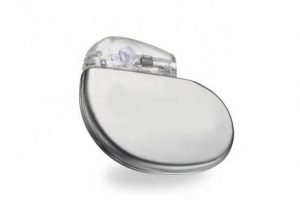Cardiac Implantable Electronic Devices
Cardiac implantable electronic devices, including pacemakers, implantable cardioverter-defibrillators (ICDs), and biventricular pacemakers. Those implantable electronic devices are designed to help control or monitor irregular heartbeats in people with certain arrhythmias and heart failure.
Suppose you have been diagnosed with conditions like bradycardia, ventricular arrhythmias, or supraventricular arrhythmias (such as atrial fibrillation and atrial flutter). In that case, your doctor may recommend the placement of a cardiac monitoring device. This device continuously gathers information about your heart rhythm and wirelessly transmits it to our cardiac device team, either automatically or through pre-scheduled transmissions when you experience symptoms. Remote monitoring enables us to assess your heart’s electrical activity as necessary, eliminating the need for frequent in-person visits to the doctor.
Implantable cardioverter defibrillator

People with advanced heart disease, heart failure, and certain inherited heart rhythm disorders are often at risk for life-threatening, fast, irregular heartbeats, called ventricular arrhythmias. These people may need an implantable cardioverter defibrillator, which delivers an electric shock to restore normal heart rhythm. An implantable cardioverter defibrillator (ICD) is a small, battery-powered device implanted in the chest. It can detect and stop irregular heartbeats (arrhythmias). An ICD continuously monitors the heartbeat and delivers an electric shock to restore normal heart rhythm when needed.
An ICD is often recommended for people with ventricular arrhythmias who have not responded to other treatments, such as catheter ablation or medication.
Pacemakers

A pacemaker is a small device that is placed (implanted) in the chest to help control the heartbeat. It is used to prevent the heart from beating too slowly. Implanting a pacemaker in the chest requires a surgical procedure.
There are two main types of pacemakers: transcutaneous pacemakers and transvenous pacemakers. Traditional models are placed under the skin and connected to the heart via electronic leads. Another type, the smaller leadless pacemaker, is placed inside the heart and does not require a transvenous lead. Pacemakers are utilized to treat bradycardia, a condition characterized by a heart rate of less than 60 beats per minute. They work by generating electrical impulses to regulate the heart’s rhythm.
A pacemaker is a small, battery-powered device designed to help regulate your heart’s rhythm. On the other hand, an implantable defibrillator is a device that monitors your heart rate and administers a powerful electrical shock to restore a normal heartbeat if your heart beats too quickly.
Biventricular Pacemakers
A biventricular pacemaker works similarly to a traditional pacemaker. Still, it uses a third lead to send electrical impulses to the heart to resynchronize the contraction of the heart’s lower left chamber or ventricle.
Also called a cardiac resynchronization device, a biventricular pacemaker is implanted when medications don’t relieve symptoms of heart failure, a condition in which the heart can’t pump enough blood to the body and the left ventricle doesn’t beat in a coordinated way. This causes the two ventricles to contract out of sync with each other. The resynchronization device coordinates the contraction of the left ventricle.
There are also biventricular defibrillators for those who would benefit from resynchronization but also need the protection of a defibrillator. This combination device can maintain a steady heartbeat and speed up or slow down a heart that’s beating too slowly or too fast. It also records information about your heart rhythm. So our specialists can assess your heart health and adjust treatment as needed.
Hejustamping-Precision Metal Stamping Parts Manufacturer in Medical Industry
Heju Stamping has over 30 years of experience in the manufacturing of precision medical metal stamping parts. Such as Implantable Pacemaker Enclosures, Blood Glucose Lancets. Certified by ISO9001 and ISO13485, we have expertise in medical devices stamping parts and their related requirements. Additionally, we are proficient in the handling of medical-grade metal. And the precise cleaning and packaging requirements required by our medical customers.
